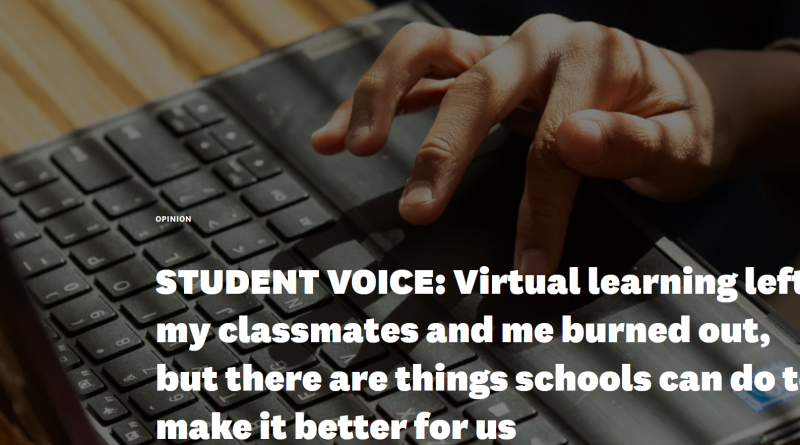STUDENT VOICE: Virtual learning left my classmates and me burned out, but there are things schools can do to make it better for us
I sat in front of my computer, scrolling through websites instead of shifting my attention toward geometry class. I felt as if I couldn’t grasp the curriculum, which led me to believe it was pointless to try to succeed in school.
I realized virtual learning had left me burned out. Between doing my assignments for hours on end and teaching myself the material, I was exhausted trying to manage it all. I earned decent grades, but did they truly reflect my learning?
Unfortunately, the answer was: no. Plus, finding the purpose in learning seemed nearly impossible, and I felt as if I couldn’t change that in any way.
My high school classmates and I need more help.
During the first few weeks of school this fall, we took tests to measure our progress. On the math test, after getting calculations wrong, I guessed on most of the questions. It lowered my self-esteem and made me feel ashamed for not learning up to the school’s expectations.
However, I knew that other students were having the same experience.
Although Montgomery County Public Schools (MCPS), where I attend high school, is proclaimed to be one of the most diverse school districts in the nation, its achievement gap continues to impact students of color like me. Many of my classmates don’t have access to a computer or adequate internet, making it hard to sign in to our virtual classes and complete assignments. Some of my classmates have other responsibilities outside of school, like financially supporting their families or helping younger siblings at home. The pandemic has led to lost learning during virtual instruction.
Virtual learning had left me burned out. Between doing my assignments for hours on end and teaching myself the material, I was exhausted trying to manage it all.
A report from Bethesda Magazine states that 40 percent fewer minority and low-income MCPS students met standards last year, something our interim superintendent, Monifa McKnight, acknowledged: “It is clear that the pandemic has resulted in a significant learning disruption over the past eighteen months,” she told the magazine.
Virtual learning also exposed the direct link between mental health issues and the achievement gap.
Many students haven’t had regular social interactions for more than a year. This has exacerbated mental health problems and contributed to low student performance and learning difficulties.
“During virtual school, I didn’t feel like myself as I used to before Covid-19,” Emily Luna, a freshman at Rockville High School, told me. “I was locked in at home and stuck in my room, staring at a computer all day. Not being able to see my friends and teachers made me feel alone.”
Keeping this in mind, MCPS and other districts should prioritize mental health by increasing their counselor-to-student ratios and creating safe areas for check-ins. Doing so would allow counselors to set more time aside to help students stressed out by school or any other circumstances. It would also expand access for students, allowing them to have one-on-one counseling sessions and focus on their mental health concerns.
With expanded school services, mental health would be less stigmatized, which, in turn, would encourage more students to reach out to community services and resources. It would provide outlets for students to express themselves as well as foster the idea that schools are supposed to be spaces to help them, not degrade them because of a single bad score on an exam, for example.
Furthermore, in order to make up for learning loss, there should be intervention and tutoring sessions available before and after school so that students won’t have to miss lessons during regular hours.
Personalized guidance from teachers during these tutoring sessions would allow students to delve deeper into the initially condensed curriculum and ask questions, which would boost their confidence back in the classroom. For students who prefer peer interaction, clubs could offer tutoring with school support and resources. For such clubs that already exist, more attention and funding could be provided to ensure that students know about them and can access them.
Superintendent McKnight acknowledged in her interview with Bethesda Magazine that such changes will demand “being intentional and direct to know each learner, to know what their learning needs are and address them.” She emphasized that no student should be left behind in the school system.
As students slowly readjust to the in-person setting, it is important to understand that virtual learning has impacted everyone to different degrees. Many solutions need to be made readily available so that students who need more help adapting can get the support they need.
Regardless of whether remote learning altered students’ academic progress or mental health, schools’ top priority should be to create an inclusive environment where all students are learning to the best of their ability.
Source: https://hechingerreport.org/student-voice-virtual-learning-left-my-classmates-and-me-burned-out-but-there-are-things-schools-can-do-to-make-it-better-for-us/




